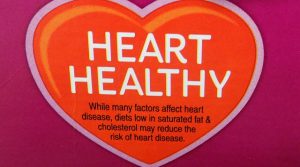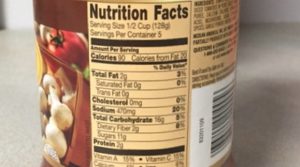
Not all front of the box labels are approved and defined by the FDA. Learn what health claims are approved for use. Photo Source: Kendra Zamojski
For those of us who read food labels, grocery shopping can be a confusing maze of health claims enticing us to make what look like healthy choices. But, are these choices really healthy? When I noticed that my shampoo was gluten-free, I decided it was time to refresh my knowledge on food and product labels and figure out what is behind the label.
The Nutrition Labeling and Education Act of 1990, regulated by the Food and Drug Administration (FDA), requires the labeling of most food and sets consistent standards for certain nutritional content and health claims. Much of the consistent information we find on food products is the result of this regulation. Food products must contain the Nutrition Facts panel, use common household measurements for serving sizes, and clearly identify any food allergens. Ingredients must be listed in descending order by weight using common names and clearly identifying certified color additives such as “FD&C Red No. 40” or “Red 40.” Raw vegetables, fruits, and seafood are exempt from nutrition labeling requirements.
The FDA regulates the use of the word “healthy” on food products. To use this term, a food product must be low in fat and saturated fat, low in cholesterol, contain less than 480 mg of sodium, and contain at least 10% of the Daily Value per serving for vitamins A, C, calcium, iron, protein, or fiber. Exceptions include raw fruits and vegetables; or a single ingredient or mixture of frozen or canned fruits and vegetables; and enriched cereal-grain products. Seafood and meat products and main dishes or meals have slightly different regulations to meet the “healthy” criteria.
The United States Department of Agriculture (USDA) regulates and enforces the use of “certified organic”. To use the USDA certified organic seal, the final product must follow strict production and handling standards. Products with this seal have completed a certification process meeting standards in soil quality, animal raising practices, and pest and weed control, and certifying that they have not used synthetic fertilizers, sewage sludge, irradiation, or genetic engineering.
The USDA also regulates labels for meat and meat products. “Certified” means the USDA has officially evaluated a meat product for class, grade, or other quality characteristics (e.g., “Certified Angus Beef”). Products labelled “natural” must not contain artificial ingredients, added color, and must be minimally processed. The label must explain the use of the word “natural” such as “no artificial ingredients; minimally processed”. Meat and meat products claiming “no hormones added” cannot be used on the labels of pork or poultry unless it is followed by a statement that says “Federal regulations prohibit the use of hormones.” Beef products can make the claim if the producer has documentation showing no hormones have been used in raising the animals. Meat and poultry producers must also provide appropriate documentation that animals were raised without antibiotics to use the label “no antibiotics added”. The term “Chemical free” is not allowed on labels.
Not all front-of-the-box marketing terms and labels are defined by the FDA. When reading labels and deciphering health information, watch out for misleading terms and health claims that seem to good to be true. Learn what health claims are approved and which ones are not. Remember, packaging is designed to attract your attention and entice you to make a purchase. Read the Nutrition Facts panel and ingredients list to make the healthiest choice for you and your family.
Here are some other approved labels:
Juice: Juice must be 100% juice. If less than 100% juice, the product must use the terms cocktail, beverage or drink.
High or Excellent Source: Contains more than 20% of the Daily Value per serving.
Good Source: Contains 10-19% of the Daily Value per serving.
Lean: Seafood or meat contains less than 10 g total fat, 4.5 g or less saturated fat, and less than 95 mg cholesterol per serving.
Extra Lean: Seafood or meat products contain less than 5 g total fat, less than 2 g saturated fat and less than 95 mg cholesterol per serving.
Fiber Claims: If a product makes a fiber claim but the food is not low-fat, then the label must state the total fat per serving.
Antioxidant Claims: The nutrients must be included as part of the claim for example, high in antioxidant vitamins C & E.
Whole Grain and Heart Disease Claims: Food product contains 51% or more whole grain ingredients.
Gluten-free: This is a voluntary label for food products that are either naturally gluten free or gluten (e.g., wheat flour) has been removed to less than 20 ppm.
References:
A Food Labeling Guide: Guidance for Industry. 2013. Available at: https://www.fda.gov/downloads/food/guidance%20complianceregulatoryinformation/%20guidancedocuments/foodlabelingnutrition/foodlabelingguide/ucm265446.pdf
McEvoy, M. Understanding the USDA Organic Label. 2016. Available at: https://www.usda.gov/media/blog/2016/07/22/understanding-usda-organic-label
Questions and Answers: Gluten-Free Food Labeling Final Rule. Available at: https://www.fda.gov/Food/GuidanceRegulation/GuidanceDocumentsRegulatoryInformation/Allergens/ucm362880.htm
Meat and Poultry Labeling Terms. Available at: https://www.fsis.usda.gov/wps/portal/fsis/topics/food-safety-education/get-answers/food-safety-fact-sheets/food-labeling/meat-and-poultry-labeling-terms/meat-and-poultry-labeling-terms
Family and Consumer Sciences Agent III
Interim -Northwest District
155 Research Road, Quincy, FL
Office: 850-875-7135
Email: hughson@ufl.edu
- Mental Health at Work: Prioritizing Well-Being in the Workplace - February 5, 2025
- Mental Health: It’s Your Job! - December 6, 2024
- Meet Your FCS Agent – Kendra Hughson - February 21, 2021

